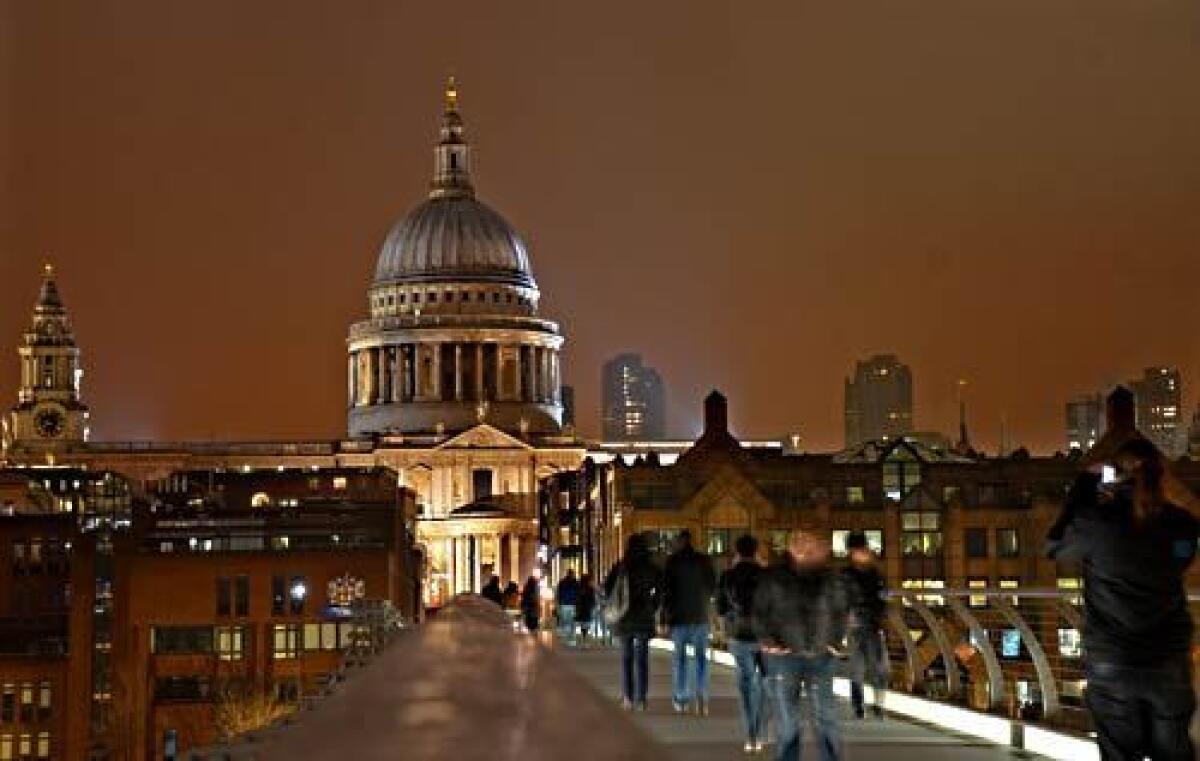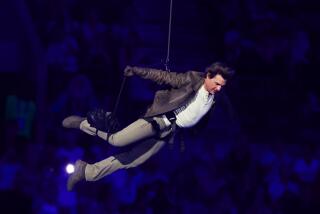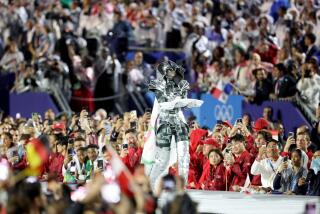Whatâs new in London since the last big royal wedding

Reporting from London â So you hate royal weddings. Or you love them. Or maybe youâve caught yourself attending to arcane details of Prince William and Kate Middletonâs plans for April 29, but you canât say exactly why.
Hereâs one reason: They defy time.
Start with just the idea of monarchy. It may be a deadly serious issue in the Middle East, but as practiced in Britain of late, it all seems so quaint and bygone. Who else in the 21st century gets to walk a red carpet without an agent taking 10%?
Yet a few Fridays from now in London, you can count on a Gothic church, a carriage procession from that church to Buckingham Palace, great queues of commoners and vast inventories of souvenir spoons. To watch a royal wedding is to imagine a world that doesnât change.
But it does, fortunately. Iâve just spent several days at London landmarks reminding myself of whatâs been built or transformed â and discovering how dramatically the churches have raised their tourist prices â since Londonâs last epic (âepicâ being the operative word) royal wedding on July 29, 1981.
It seemed logical to start with St. Paulâs Cathedral, which is where Prince Charles wed Lady Diana Spencer (although itâs not where William will wed Kate).
Three decades ago, it cost a tourist nothing to stroll the cathedralâs checkerboard floor â and what a floor it is. From it, you gaze up, up, up into the overwhelming 365-foot dome designed in the late 17th century by Christopher Wren, Londonâs original star architect. You did have to pay, however, to climb the 257- or 259-step spiral stairwell (it depends on whoâs counting) to the Whispering Gallery that circles the interior of the dome, offering a view from 99 feet above the worshipers below.
Itâs hard to imagine a bigger target, yet somehow, though German bombing leveled many a London building during World War II, British forces kept St. Paulâs safe. At warâs end in 1945, 30,000 Britons gathered here to celebrate. When wartime leader Winston Churchill died in 1965, authorities brought his body here to lie in state.
Interactive map: Places to see, shop, dine and stay in London.
And when Charles and Diana married here in 1981, every detail got a good going-over: the coupleâs decision to leave âobeyâ out of Dianaâs vows; the red carpet they walked on; the 25-foot train of Dianaâs dress; the 20-year-old bride stumbling on the full name of her husband-to-be, the 32-year-old groom mixing up his pronouns on âworldly goods.â
The BBC estimated 600,000 people in the streets and 750 million watching televisions worldwide that day. The coupleâs first son, William, was born less than a year later, and a second son, Harry, followed in 1984. The couple separated in 1992 and divorced in 1996, just a year before Dianaâs death with two others in a Paris car crash. When Prince Charles quietly married Camilla Parker Bowles in a civil ceremony in 2005, it was at Windsor Guildhall, far from here.
These days itâs free to see St. Paulâs if youâre worshiping. But tourists will pay about $24 for adults and $9 for most children, with a slight discount for families. (Some days, there is a fast-track line for people who have prepaid their admission fee online, as I did. But other days, like the day I turned up, there is no fast-track line.)
Thereâs no doubt that it costs a fortune to keep the place whole as so many visitors troop through. But in my few moments by the entrance, I heard two British visitors hesitate at the cost.
âIâll give it a miss and come back later,â one man said. The other planned on returning just before closing, hoping to slip in for free.
Once youâre in, if your legs are willing and your nerves can take the close quarters of the stairwell, climb the steps to the Whispering Gallery, enjoy the view and test the acoustics (said to make whispers audible at 100 feet).
Just 119 more steps will take you to the Stone Gallery and its sweeping balcony views of the city skyline, including all sorts of strangely shaped skyscrapers that have risen in the last decade. Here, as you spy the tiny people walking the streets far below, is a fine place to remind yourself that in 1673, when Wren got approval from King Charles II for his design of this church, nobody understood it especially well. Isaac Newton was still more than a decade away from publishing his law of universal gravitation.
For the fittest of all travelers, 152 more steps will take them to the Golden Gallery, about 280 feet above the floor. I canât tell you about that view, because it was a cold and cloudy day, and I was tired. Down, down, down I clambered to the crypt, where I could sprawl on the carpet and be surrounded by âOculus,â a 30-minute series of 270-degree films, unveiled in July and shown continuously.
With images flickering on three walls and the score resounding deeply, âOculusâ traces the cathedral through the centuries, from the Great Fire of London in 1666 that destroyed it to the blitz of 1940-1941 to the rousing sounds of a contemporary choir rehearsal. See it.
Then step out of the cathedral and follow the pedestrian masses heading south. Youâre about to do something nobody could do here 30 years ago: stroll across the Thames on a footbridge.
The Millennium Bridge, a few blocks south of St. Paulâs, is a steel suspension span, about 1,000 feet long, that puts you into a parade of international visitors who tend to grin and linger even in raking winter winds. The bridge opened in June 2000 â and was shut down within days because its lateral movements gave many people the willies. It reopened in 2002 after a steadying retrofit and can surely be credited for tempting tourists toward the implausible hulk at its southern end.
In 1981, this vast building was the oil-fired Bankside Power Station, designed by the same architect who sprinkled Britain with those beloved red telephone boxes (Giles Gilbert Scott). But oil prices had grown prohibitively high. That year, authorities closed it.
When the site reopened in 2000, it was as a world-class museum â the Tate Modern, a haven for art since 1900, and temptingly visible from the viewing decks of St. Paulâs. Many of its 4 million annual visitors pay to see special exhibitions, but it costs nothing to roam the permanent collection or Turbine Hall, the gaping ground-floor space in which the museum displays a commissioned work each year.
The current work, a big bed of porcelain sunflower seeds by Chinese artist Ai Weiwei, didnât do much for me, nor did the museumâs explanatory note. (âWhat you see is not what you see, and what you see is not what it means.â) But lots of other things did.
The Monet water lilies, painted on a canvas thatâs almost the size of a backyard pool, will likely stop you in your tracks. The six Gerhard Richter abstracts may bewitch you. I merrily worked my way up to the seventh floor, then nipped into the restaurant just as it was opening for Saturday night dinner. (Garganelli pasta with mushrooms and a view of the Thames â both excellent.)
What else couldnât you do in London in 1981? Hereâs a partial list:
Glide on a Boris Bike. Notice the many Barclays Cycle Hire stands? They started popping up around town last summer, and there are dozens now. Londoners call them Boris Bikes, after Mayor Boris Johnson. (Thirty years ago, British political power was more centralized and London didnât even have a mayor.) For a few pounds, you can grab one of the light blue two-wheelers from a stand, ride, then leave it at a stand near your hotel and walk home. It takes some nerve to share the lanes with London traffic, especially on the busiest thoroughfares, especially as an American accustomed to the other side of the street. But I did it in Soho and lived.
Buy a snarky commemorative plate. Soon after the engagement announcement, the people at KK Outlet Gallery, in East Londonâs Hoxton Square, commissioned some cheeky designers to create unofficial collector plates. âThanks for the day off,â one says, referring to the national holiday for the wedding, which falls on a Friday. âIt should have been me,â another says. Despite a price tag of about $36 each, plus shipping, the gallery sold about 3,000 the first week. âIt crashed our website,â manager Danielle Pender said. There was plenty of wedding cynicism afoot in 1981, Iâm sure, but if anybody put it on a plate, I havenât found it yet on EBay.
See open-air Shakespeare on the old Globeâs old turf. Next door to the Tate Modern is Shakespeareâs Globe, an open-air theater that replicates the original Globe and stands just a few hundred yards from the site where Shakespeare and Lord Chamberlainâs Men put on their shows four centuries ago. Conceived by American actor and director Sam Wanamaker (who died in 1993), this Globe opened in 1997 and offers shows from April through October (www.shakespearesglobe.com), with tours and an exhibition area open year-round.
Walk unhindered from Trafalgar Square to the National Gallery. The laws of London and gravity are such that you will sooner or later find yourself in Trafalgar Square, home of Nelsonâs Column, the four sculpted lions that guard it and a band of street performers who work the crowd of resting tourists. For decades, the roar and menace of traffic undercut pedestrian pleasures. But in 2003, local leaders banished vehicular traffic from the north side of the square and added a cafĂŠ. This means uninterrupted strolling between the lions and the National Gallery of Art and more space for the jugglers, the magicians and you.
Follow Prince Charlesâ second career as an architecture critic. The National Gallery specializes in art from 1250 to 1900, and for years its leaders wanted to expand. But when they began to move forward and publicized one proposal for a new wing in 1984, the traditionally inclined prince couldnât hold back. Imagining this postmodern nonsense on Trafalgar Square, he declared, was like finding a âmonstrous carbuncle on the face of a much-loved and elegant friend.â And Charles got his way. The museum hired a different (but still postmodern) architectural team, Robert Venturi and Denise Scott Brown. Their Sainsbury wing, which opened in 1991, might still annoy some traditionalists with its âquotationsâ of disparate elements from other buildings. But the Sainsbury Wing gave the museum more room for its Renaissance paintings, shop and restaurants, and we canât complain about that.
Escape the rain in Great Court of the British Museum. In 1981, the British Museum had the Elgin Marbles (a coveted set of sculptures and architectural details also known as the Parthenon Marbles, removed from Athens in the early 1800s), but Greece wanted them back. In 2011, the British Museum still has them, and Greece still wants them back. But other things have changed. In 2000, the museum reorganized itself and unveiled a new Great Court, an airy two-acre courtyard space covered with a glass-and-steel skylight roof. It not only eases access to the museumâs exhaustive collections, but it also makes a fine refuge from wet weather.
Look down on Big Ben. Was it really a good idea to plunk down an overgrown carnival attraction just across the river from perhaps Londonâs most beloved landmark? I wasnât so sure, but I bought a ticket to the Eye anyway, largely because there was no line that night. (The price is about $55 per adult for the no-waiting ticket. In summer, reserve in advance.) After a brief film with kid-pleasing effects, we boarded one of the 32 egg-shaped, climate-controlled, glass-walled capsules as the wheel continued its stately rotation (0.6 mph; and, yes, there is time for somebody to close the hatch). Then the capsule rose over the city with a dozen of us inside, the Thames bent below and the city lights sprawled. It was brilliant â at least, it was if you didnât cower on the bench staring at your knees, as one man did in our capsule while his wife and son oohed and aahed. From the highest point of the 30-minute ride, about 440 feet up, you can admire the tower and green roof of Big Ben as they rise below you (about 315 feet tall) across the water.
From the London Eye, itâs a 15-minute walk to Westminster Abbey, where William and Kate are to be wed at 11 a.m., Greenwich Mean Time, on April 29. Whenever you go during open hours, you wonât be alone. (I showed up midafternoon on a February weekday and waited 20 minutes.)
The abbey is as intricate as St. Paulâs is vast, and there may be no better place to see a sunbeam stream through stained glass and strike a stone smoothed by time. Thanks to a mirrored table inside, you can admire the ceiling without wrenching your neck.
You may, however, strain your imagination considering this: William the Conqueror was crowned on this site in 1066. As was Queen Elizabeth II in 1953 (after assuming the throne in 1952). About 3,000 of Britainâs best-known men and women have been buried here, and in 1997, the funeral of Diana, Princess of Wales, was held here. (She is buried on her familyâs private estate outside London.)
On the day of her funeral, the BBC has estimated, a million people assembled along the cortege route, and as many as 2.5 billion people watched on television. For the wedding of her older son, the Wall Street Journal has forecast a TV audience of 2 billion, a combined Internet and radio audience of 400 million and a likely turnout of 800,000 in the streets.
Once your eyes have adjusted to the light inside the abbey, you notice the march of historic names across its stone markers, and the strains of âPomp and Circumstanceâ may sneak into your head. Geoffrey Chaucer. Mary, Queen of Scots. Isaac Newton. Explorer David Livingstone (whose heart was left in Zambia). Composer Edward Elgar (who wrote âPomp and Circumstanceâ). In the Poetsâ Corner: Charles Dickens, Rudyard Kipling, Robert Browning and dozens more, including memorials to many who are buried elsewhere.
âThese guys that weâre standing on were important to the whole world,â a verger (guide) named Beryl Kearny told me. âAnd some would disagree, but I love that we have the courage to bury men like this in here,â she added, nodding toward Charles Darwinâs marker. (Darwin died in 1882, 23 years after detailing his theory of evolution, and was promptly entombed here.)
In the 1980s, visitors could enter the abbey at no cost, although some areas required an access fee, Kearny said. Since the late 1990s, church leaders have sought to cover more of their costs by charging all visitors who arenât worshiping. Adults pay about $26; a family of four, about $61.
There are a few new names since 1981, too, including Laurence Olivier, who died in 1989, and Martin Luther King Jr., whose statue is one of 10 the church added in 1998 to honor 20th century Christian martyrs. In fact, Kingâs statue, which stands over the Great West Door, just might have a better firsthand view of this royal wedding than any living American.
âThereâll always be an England,â as performers Vera Lynn, Tiny Tim and the Sex Pistols have sung or said, each in his or her own time and way. And as long as there is an England, you can bet that even in its oldest quarters, new surprises await.
More to Read
Sign up for The Wild
Weâll help you find the best places to hike, bike and run, as well as the perfect silent spots for meditation and yoga.
You may occasionally receive promotional content from the Los Angeles Times.







